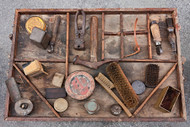Common Leather Care Mistakes
Posted by Daniel Sutton on Apr 1st 2014
We all do dumb things. Rubbing a sloppy banana peel all over our shiny new pigskin briefcase doesn’t have to be one of them. We here at Chamberlain’s love a good home remedy as much as the next person, but let’s sort fact from fiction. After all, it’s your leather that’s at stake. One wrong move can run the risk of seriously discoloring your favorite wallet or drying up your expensive leather coach bag. If you’re hoping to dodge the need for tedious leather repair, keep a look out for these most wanted leather care mistakes.
Don’t use Household Cleaners
Remember Gus’s obsession with Windex from My Big Fat Greek Wedding? That magic spray seems to work on just about anything: bugs, stains, jewelry – even acne! Unfortunately, every tool has its Achilles’ heel, and leather is the household cleaner’s. Think your favorite dish soap or general cleaner is a dirty leather hand bag’s saving grace? Big mistake. Leather has a slightly acidic pH level of 4.5. Mild dish soap, on the other hand, possesses a basic pH level between 7-8, and other general cleaners, such as Borax, usually find their way to around a basic 10. The contrast between leather pH levels and the cleaners’ during contact damages leather fibers and can weaken its integrity over time. This leather pH damage is typically characterized by – you guessed it – cracked and dry leather.
Avoid Saddle Soap
Say what now? Saddle Soap is harmful to my leather? The clue is in the name. As we mentioned earlier, soap tends to be basic on the pH scale, and is thus hazardous to acidic material, such as leather. That’s not to say that Saddle Soap is all bad. During the 1800s, saddle soap was used after leather was tanned to restore its supple texture. The high amounts of fat can also give the leather a nice shine, but hinder its ability to remove dirt, grease, and oils. Oil that fails to rinse will dry and accelerate the already harmful alkaline effects, causing considerable leather pH damage and eventually cracking and drying the leather out. As far as leather care mistakes go, it can be a doozy if used to often, and is best avoided for leather cleaning purposes.
Strictly Conditioning is Bad
We get it. You want to get to the good stuff: silky leather at your fingertips, oceans of smooth pleasure to the touch. It’s a tantalizing sensation. But patience is a virtue, and good things come to those who wait. Take a little time to look below the surface, and you’ll find leather can absorb the dirty stuff fast. If dust and grime goes unchecked for too long, oil applied from leather conditioners can cause the dirt to clog up pores and result in dry leather. Worse still, the leather conditioner will actually trap contaminants within said pores, so they become more difficult to remove. So it's a good idea to periodically start with a good leather cleaner like Chamberlain's Straight Cleaner No. 2. Give your baby a good washing to cleanse those pores, and then bring on the good stuff (your leather conditioner, lest you forget). Also take care not to use too much conditioner, as you may wind up giving your leather a mushy texture and make it vulnerable to stretching, another one of those hefty leather care mistakes.
Using Only Water is also Bad
There’s an inverse to only using leather conditioner. And guess what? It’s a surprisingly common leather care mistake. Water. Now we get the whole shebang. Water’s great: small cost, big supply, ages and ages of tried and true results. It would be cliche of us to tell you we wouldn’t be here without it. But let’s be honest. You aren’t going to spend the rest of your life only drinking H2O. Milk is also good for the body, providing an excellent source of calcium and Vitamin A. In the same way, leather conditioner provides leather with the nutrients it needs to keep its protein bonds strong and healthy—neither of which you’ll find abundant in water. And for those heavy duty clean ups, excess water that sinks deeply enough into leather fibers can make temporary bonds with the oils that are keeping the leather lubricated. When the water evaporates, the oils float to the surface with the water and weaken the leather’s integrity. If you want your bag to keep the polish and sheen it bedazzled you with when you first fell in love, balance is everything. Give that leather some milk!
That’s all we’ve got for now. Remember, life’s all about making mistakes (especially leather care mistakes!), but it’s also about learning from them. And there are few better ways to learn than learning without consequence. So take our advice and skip these leather headaches, for your briefcase’s sake.
Contributors
Stephanie Clarke
Chris Repp (www.leatherhelp.com)
Got more leather questions? Suggest a blog topic to us here!

